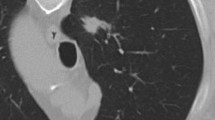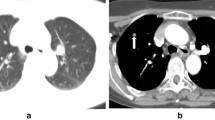Abstract
Objective
To describe our initial experience with percutaneous transthoracic biopsy (PCNB) of lung nodules using C-arm cone-beam CT (CBCT).
Materials
Seventy-one consecutive patients with lung nodules of 30 mm or smaller underwent CBCT-guided PCNB using a coaxial cutting needle. We evaluated the procedure time, coaxial introducer dwell time, the numbers of pleural passages, coaxial introducer repositionings and CT acquisitions, as well as the technical success rate and radiation doses. Diagnostic accuracy, sensitivity, specificity and incidence of complications were also evaluated.
Results
PCNB was performed for 71 nodules: 63 solid, 6 part-solid and 2 ground-glass nodules. The procedure time, coaxial introducer dwell time, numbers of pleural passages, coaxial introducer repositionings and CT acquisitions were 17.9 ± 5.9 min, 8.7 ± 3.8 min, 1.1 ± 0.4, 0.2 ± 0.5 and 2.9 ± 0.7, respectively. The technical success rate was 100% and the radiation dose was 272 ± 116 mGy. Thirty-six nodules (50.7%) were diagnosed as malignant, 25 (35.2%) as benign and 10 (14.1%) as indeterminate. Diagnostic accuracy, sensitivity, specificity and incidence of complications were 98.4%, 97%, 100% and 38%, respectively. Complications included pneumothorax in 18 patients (25.4%), haemoptysis in 10 (14.1%) and chest pain in one (1.4%).
Conclusion
Under CBCT guidance, PCNB of lung nodules can be performed accurately, providing both real-time fluoroscopic guidance and CT imaging capabilities.



Similar content being viewed by others

References
Ohno Y, Hatabu H, Takenaka D et al (2003) CT-guided transthoracic needle aspiration biopsy of small (<= 20 mm) solitary pulmonary nodules. AJR Am J Roentgenol 180:1665–1669
Gupta S, Krishnamurthy S, Broemeling LD et al (2005) Small (<=2-cm) subpleural pulmonary lesions: short- versus long-needle-path CT-guided biopsy—comparison of diagnostic yields and complications. Radiology 234:631–637
Frank K, Wacker BM (2009) CT- and MR-guided interventions in radiology. In: Wacker FK, Meyer B (eds) Interventions using C-arm computed tomography. Springer, Heidelberg, pp 370–381
Carlson SK, Felmlee JP, Bender CE et al (2005) CT fluoroscopy-guided biopsy of the lung or upper abdomen with a breath-hold monitoring and feedback system: a prospective randomized controlled clinical trial. Radiology 237:701–708
Yankelevitz DF, Vazquez M, Henschke CI (2000) Special techniques in transthoracic needle biopsy of pulmonary nodules. Radiol Clin North Am 38:267–279
Gupta R, Cheung AC, Bartling SH et al (2008) Flat-panel volume CT: fundamental principles, technology, and applications. Radiographics 28:2009–2022
Rafferty MA, Siewerdsen JH, Chan Y et al (2005) Investigation of C-arm cone-beam CT-guided surgery of the frontal recess. Laryngoscope 115:2138–2143
Reichardt B, Sarwar A, Bartling SH et al (2008) Musculoskeletal applications of flat-panel volume CT. Skeletal Radiol 37:1069–1076
Hirota S, Nakao N, Yamamoto S et al (2006) Cone-beam CT with flat-panel-detector digital angiography system: early experience in abdominal interventional procedures. Cardiovasc Intervent Radiol 29:1034–1038
Kim HC, Chung JW, Park JH et al (2009) Transcatheter arterial chemoembolization for hepatocellular carcinoma: prospective assessment of the right inferior phrenic artery with C-arm CT. J Vasc Interv Radiol 20:888–895
Wallace MJ, Kuo MD, Glaiberman C et al (2008) Three-dimensional C-arm cone-beam CT: applications in the interventional suite. J Vasc Interv Radiol 19:799–813
Carlson SK, Bender CE, Classic KL et al (2001) Benefits and safety of CT fluoroscopy in interventional radiologic procedures. Radiology 219:515–520
Daly B, Templeton PA (1999) Real-time CT fluoroscopy: evolution of an interventional tool. Radiology 211:309–315
Ko JP, Shepard J-AO, Drucker EA et al (2001) Factors influencing pneumothorax rate at lung biopsy: are dwell time and angle of pleural puncture contributing factors? Radiology 218:491–496
Miller KS, Fish GB, Stanley JH et al (1988) Prediction of pneumothorax rate in percutaneous needle aspiration of the lung. Chest 93:742–745
Kazerooni EA, Lim FT, Mikhail A et al (1996) Risk of pneumothorax in CT-guided transthoracic needle aspiration biopsy of the lung. Radiology 198:371–375
Laurent F, Latrabe V, Vergier B et al (2000) CT-guided transthoracic needle biopsy of pulmonary nodules smaller than 20 mm: results with an automated 20-gauge coaxial cutting needle. Clin Radiol 55:281–287
Tsukada H, Satou T, Iwashima A et al (2000) Diagnostic accuracy of CT-guided automated needle biopsy of lung nodules. AJR Am J Roentgenol 175:239–243
Moore EH (1998) Technical aspects of needle aspiration lung biopsy: a personal perspective. Radiology 208:303–318
Kato R, Katada K, Anno H et al (1996) Radiation dosimetry at CT fluoroscopy: physician’s hand dose and development of needle holders. Radiology 201:576–578
Rivera MP, Mehta AC (2007) Initial diagnosis of lung cancer. Chest 132:131S–148S
Scarfe WC, Farman AG (2008) What is cone-beam CT and how does it work? Dent Clin North Am 52:707–730 v
Miracle AC, Mukherji SK (2009) Conebeam CT of the head and neck, part 1: physical principles. AJNR Am J Neuroradiol 30:1088–1095
Yeow K-M, Su IH, Pan K-T et al (2004) Risk factors of pneumothorax and bleeding. Chest 126:748–754
Swischuk JL, Castaneda F, Patel JC et al (1998) Percutaneous transthoracic needle biopsy of the lung: review of 612 lesions. J Vasc Interv Radiol 9:347–352
Geraghty PR, Kee ST, McFarlane G et al (2003) CT-guided transthoracic needle aspiration biopsy of pulmonary nodules: needle size and pneumothorax rate. Radiology 229:475–481
Acknowledgments
This study was supported by a grant from the Korea Healthcare Technology R&D Project, Ministry for Health, Welfare & Family Affairs, Republic of Korea (A070001).
Author information
Authors and Affiliations
Corresponding author
Rights and permissions
About this article
Cite this article
Jin, K.N., Park, C.M., Goo, J.M. et al. Initial experience of percutaneous transthoracic needle biopsy of lung nodules using C-arm cone-beam CT systems. Eur Radiol 20, 2108–2115 (2010). https://doi.org/10.1007/s00330-010-1783-x
Received:
Revised:
Accepted:
Published:
Issue Date:
DOI: https://doi.org/10.1007/s00330-010-1783-x



